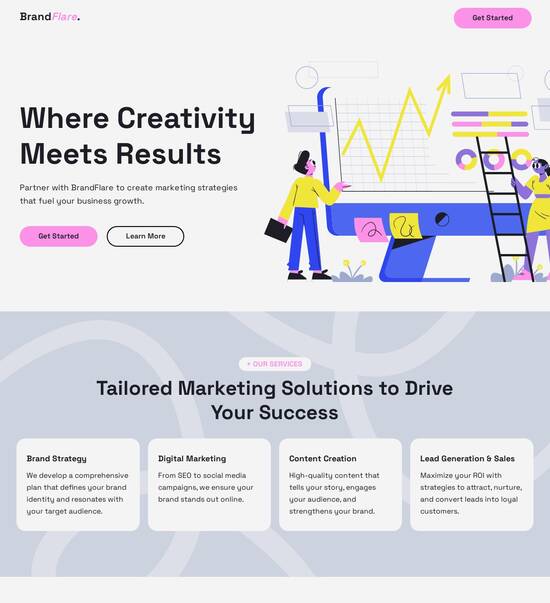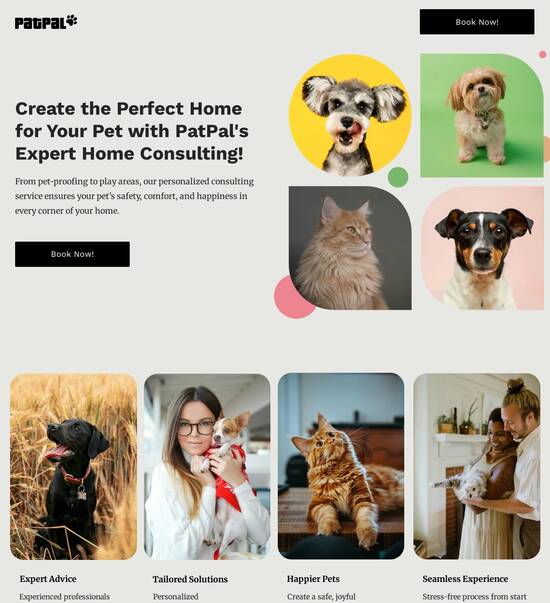
Portfolio page template optimized for Digital photo frame
Explore Similar TemplatesAbout template
Design using a responsive portfolio page template that delivers a flawless experience on Digital photo frame. Try Instapage today!
Recommended templates

Easy to build without coding
With the intuitive drag-and-drop builder, anyone on your team can create high-converting pages without any knowledge of code or design. Make enhancements to your landing page with custom widgets using Javascript, HTML/CSS, or third-party scripts.

Multiple layouts for any industry and goal
Select from 500+ landing page layouts built to boost conversions across industry-specific scenarios. Customize them by adjusting fonts, adding images, and generating on-brand content with the AI assistant. Quickly scale with Instablocks® and Global Blocks that you can save, reuse, and update globally.

Loads fast and looks polished on any device
Every template is responsive, which means they present professionally on any device and load blazingly fast with our Thor Render Engine. You can also power them up with Google AMP technology to deliver an unparalleled mobile experience and drive higher conversions.

Robust analytics & experimentation
Get real-time updates and reporting across all your devices, showing the number of visitors, conversions, cost-per-visitor, and cost-per-lead. Launch AI-powered experiments, run A/B tests, and use heatmaps to analyze user behavior, then optimize your landing page to maximize conversions.







Easy to build without coding
With the intuitive drag-and-drop builder, anyone on your team can create high-converting pages without any knowledge of code or design. Make enhancements to your landing page with custom widgets using Javascript, HTML/CSS, or third-party scripts.
Multiple layouts for any industry and goal
Select from 500+ landing page layouts built to boost conversions across industry-specific scenarios. Customize them by adjusting fonts, adding images, and generating on-brand content with the AI assistant. Quickly scale with Instablocks® and Global Blocks that you can save, reuse, and update globally.
Loads fast and looks polished on any device
Every template is responsive, which means they present professionally on any device and load blazingly fast with our Thor Render Engine.
Robust analytics & experimentation
Get real-time updates and reporting across all your devices, showing the number of visitors, conversions, cost-per-visitor, and cost-per-lead. Launch AI-powered experiments, run A/B tests, and use heatmaps to analyze user behavior, then optimize your landing page to maximize conversions.
All the features you need to build lead-generating landing pages
Explore more featuresLearn how to build top-performing landing pages for any goal
FAQs
Leading the way in building high-performing landing pages





A complete guide to optimizing landing pages with Instapage
Landing pages are a crucial element of digital marketing strategies. With Instapage's all-in-one platform, marketers can create high-converting landing pages that maximize return on investment (ROI). This guide will walk you through the steps of leveraging Instapage to boost your campaigns and drive more conversions.
Understanding the power of Instapage
Instapage is designed to empower marketers regardless of their team size or budget. With over 100 templates and lead-generation elements, it simplifies the page-building process, allowing users to create landing pages without coding knowledge. This adaptability caters to various industries such as business services, tech/SaaS, and education.
- Customizable templates: Choose from a vast library of pre-built templates suitable for multiple verticals.
- User-friendly interface: Instapage's drag-and-drop builder provides a seamless experience, aiding marketers in page creation without tech expertise.
- Lead generation tools: Integrate forms and call-to-action buttons easily to capture leads effectively.
Step 1: Building landing pages with Instapage
Creating an effective landing page is straightforward with Instapage. Start by selecting a template that aligns with your campaign goals.
- Choose a template: Find a design that reflects your brand and speaks to your target audience.
- Utilize Instablocks: Drag and drop customizable blocks for sections like testimonials, FAQs, or features.
- Preview and publish: Always preview your page before publishing to ensure it meets your expectations.
Step 2: Optimizing for conversions
To ensure higher conversions, use Instapage's built-in optimization features.
- Conduct A/B testing: Test different versions of your landing page to identify which performs better.
- Analyze heatmaps: Use heatmaps to see where users are clicking most and optimize accordingly.
- Monitor performance: Leverage the analytics dashboard to assess the effectiveness of your landing pages and make data-driven decisions.
Step 3: Personalizing user experiences
Delivering personalized content can significantly enhance user engagement.
- Dynamic text replacement: Tailor your landing page content to match the keywords that brought users to your page.
- AdMaps integration: Align ads with landing pages to create a cohesive journey for users.
- Audience-level tracking: Use data tools to measure performance and tweak content for specific audience segments.
Utilizing Instapage effectively can lead to significant improvements in your digital marketing campaigns, ultimately maximizing your ROI.
Ready to elevate your landing pages? Start using Instapage today for a comprehensive approach to digital marketing and watch your conversions soar!
People also ask about Portfolio page template optimized for Digital photo frame
The art of presentation: crafting a portfolio page template optimized for digital photo frames
Understanding the digital photo frame landscape
Digital photo frames have transformed how we display images, evolving from simple picture frames into sophisticated devices that bring photos to life. Typically, these frames are equipped with an LCD screen that rotates images, allowing users to customize which photos are shown. They have gained traction not only in homes but also in businesses, showcasing professional work or memorable events effectively.
The rise in popularity of digital photo frames reflects a shift in how we consume visual content. Instead of cluttering our spaces with physical prints, photos can now be showcased in a more organized and dynamic way. This transition has spurred interest among creators looking to present their work digitally through customized portfolio pages that are tailored for these innovative devices.
The importance of a portfolio for creators
For creators, having a portfolio is crucial in showcasing their work. It's more than just a collection of images; it’s a visual narrative that conveys their style, creativity, and professionalism. A well-structured portfolio can engage an audience, drawing them in and encouraging them to explore more of the creator's work.
This engagement is especially important for digital displays, where the immediacy of visuals can make or break user interest. By carefully curating a portfolio that utilizes an optimized template, creators can effectively communicate their artistic vision, engage viewers with aesthetics, and ultimately drive interest in their services or products.
Designing with purpose: features of an optimized template
Creating a portfolio page template designed for digital photo frames requires attention to various essential elements, which significantly enhance user experience. Key components include high-resolution image displays that ensure clarity and excellence in showcasing work. This is pivotal as the quality of images directly affects perceived professionalism.
Additionally, a user-friendly navigation design streamlines the experience, ensuring that visitors can easily find their way through the portfolio. Sections like About, Work, and Contact help structure content in a familiar manner, making it easier for viewers to digest information about the creator and their work efficiently.
High-resolution image display: Ensures clarity and vibrancy of photos.
User-friendly navigation: Facilitates easy access to various sections.
Informational sections: Provides context and background on the creator.
Styling your template for visual appeal
Visual appeal is critical in a portfolio template. A cohesive color scheme can create an inviting atmosphere, attracting viewers immediately. Consider using complementary colors that not only represent the creator's branding but also enhance the overall viewing experience.
Typography, too, plays a vital role—select styles that enhance readability and convey professionalism. Additionally, the effective use of white space mimics cleanliness and sophistication, allowing the showcased images to breathe and take center stage. A thoughtfully styled template ensures that the creator’s work remains prominent and appealing.
Dynamic presentation modes for engaging display
When it comes to engaging viewers, slideshow features are a powerful tool in portfolio templates. Automatic transitions allow images to change smoothly, creating an effortless flow of visual storytelling. Setting appropriate timings ensures that viewers have enough time to appreciate each image fully before moving on.
Besides slideshows, integrating interactivity through click-through options can vastly increase viewer engagement. Users who can actively participate in navigating the portfolio are more likely to stay engaged. Understanding the pros and cons of grid versus carousel layouts also influences engagement levels, as different audience segments may have varying preferences.
Slideshow features: Automatic transitions to enhance visual experience.
Click-through options: Increases interactivity and viewer participation.
Grid vs. carousel layouts: Choosing the right method for your audience.
Customization: tailoring templates to individual needs
Customization is pivotal when creating a portfolio that accurately reflects a creator’s uniqueness. Incorporating personal branding elements—such as logos, taglines, and signature colors—allows for a cohesive identity across the displayed works. This branding consistency not only strengthens recognition but also helps establish trust with potential clients or viewers.
Furthermore, allowing for content personalization leads to a richer user experience. Options for static versus dynamic content display mean creators can choose how flexible and updated their portfolio remains. Modular sections can enhance adaptability, letting creators periodically refresh their work without entirely overhauling the entire layout.
The user experience journey: from visit to value
An intuitive navigation design is crucial for the user experience. Ensuring that all audience types, whether tech-savvy or novices, can easily understand how to navigate the portfolio is essential for retaining interest. A responsive design accommodates various devices, allowing viewers to appreciate the portfolio equally well, whether they are using a digital frame, a tablet, or a smartphone.
Additionally, engagement tactics such as incorporating multimedia elements like videos, animations, or even sound can significantly enhance user interaction. Including testimonials or client feedback can also provide a layer of authenticity and relatability that drives home the message of quality and professionalism.
Intuitive navigation: Designed for easy access to all features.
Responsive design: Adapts to user devices for optimal viewing.
Engagement tactics: Use of multimedia elements and feedback.
Optimizing templates for various audiences
Identifying the target audience segments is key in crafting an effective portfolio. A professional client will have different expectations compared to a casual viewer. Tailoring the template to address these diverse audience needs ensures greater relevance and resonance with each visitor, increasing the chances of positive engagement.
Utilizing analytics can inform design adaptations for better engagement. By leveraging website metrics, creators can keep track of which sections attract the most attention, and A/B testing can reveal which features resonate best with users. Continuous evaluation based on these insights allows for a more targeted portfolio presentation.
Identifying audience segments: Addressing the varied needs of visitors.
Leveraging analytics: Using metrics to refine design.
A/B testing: Finding the most engaging portfolio features.
Elevating your portfolio with integrative features
To enhance user experience, it’s beneficial to connect the portfolio to a broader digital ecosystem. Linking to social media platforms not only expands the visibility of the portfolio but can provide additional channels for interaction. Integrating an online store offers a direct purchasing option for viewers interested in the creator's work.
Documentation efforts for user support can also pay dividends in enhancing user experience. Comprehensive guides ensure that audiences, regardless of their tech proficiency, can navigate the portfolio with ease. Furthermore, regular updates to the template keep it fresh and relevant, reflecting new capabilities or trends in digital presentation.
The future of portfolio presentation
Emerging technologies are reshaping the landscape of portfolio presentations. Innovations such as augmented reality (AR) and virtual reality (VR) are beginning to influence how creators present their work. These technologies open up new possibilities for interaction and engagement, allowing viewers to experience portfolios in immersive and exciting ways.
As the digital landscape evolves, so too must the portfolios of creators. Regularly updating one’s portfolio ensures it stays relevant and meets the needs of a changing audience. Moreover, building a community around shared work and artistic interests can foster collaboration and innovation.
Final thoughts: redefining portfolio pages for modern creators
Crafting an optimized portfolio page template tailored for digital photo frames has the power to transform the presentation of a creator's work. By focusing on value-driven design, personalized experiences, and engaging multimedia elements, creators can redefine their online showcase. As technology continues to evolve, the journey of portfolio development will challenge creators to think beyond traditional displays, embracing new opportunities for connection and engagement.
Ready to skyrocket conversions?
Supercharge your ad campaigns with high-performing landing pages
Get started














